Message from the Brewery Owner
Isojiman Brewery is located in Yaizu, where the Suruga Bay, Izu Peninsula, and Mount Fuji can be seen to the east, and the southern tip of the South Alps can be seen in the far north-northwest. This is a mystical land where, according to the legend, Prince Yamato-Takeru cut down the surrounding grass with his legendary sword “Ameno-murakumo” , set the grass on fire, to counter enemy fire attack that was enclosing him, and escaped from the trap. To the southwest, the clear Oi River, which springs from Shirane-sanzan Three Mountains of South Alps and Mount Aino (one of the Japanese Hundred Famous Mountains), gently flows 170km, giving its blessing to the Shida plains in the form of famous, excellent water. Because water occupies 65-70% of the value of sake brewing, we are thankful for the blessing of water which is compatible with sake brewing.
Sake rice is also a very important raw material. We carefully select the variety and production area, such as Yamada Nishiki of Special Area A grown in the Tojo area of Hyogo Prefecture, Aiyama, or Gohyakuman-goku. Sake rice is a blessing from nature and its quality varies each year due to differences in weather and temperature. We strive to brew sake which stably conveys our firm conviction, sensing even the slight difference of the rice each year.
Sake brewing is the interweaving of man and nature, and we are testing the limits. Our sake is a “trickle” born from the difficulty of sake brewing and the affection guarding over it.
Many years ago, Louis XIV said “It takes 15 minutes to create 20 lords, but centuries to create an artist (art)”. While Louis XIV may have had something else in mind, the gist of his words is the same — genuine sake with a long history is a world- class artwork.
From 1830 until today, we have sought something new while protecting the tradition. Although this is a small brewery, we have continued to work toward the quintessence of sake brewing, honing and improving our skills with the goal of “tradition, innovation, and essence.” We will continue to brew sake with affection and a humble attitude, praying that “Isojiman” continues to be supported by our customers and that “Isojiman” continues to satisfy our customers.
Sake is a living thing. To ensure quality, please purchase our sake from our exclusive distributors. After purchase, store the sake in a refrigerator until opening. Cold sake is best drunk when not too cold, and warm sake, not too warm. After opening Daiginjo, the delicate change in taste and aroma can be enjoyed from two to seven days.
Sake Brewing of Isojiman
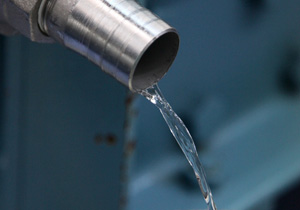 At the end of October, a cool wind begins to blow in the morning and evening. And Isojiman”s sake brewing begins with a religious service honoring the God of sake brewing.
At the end of October, a cool wind begins to blow in the morning and evening. And Isojiman”s sake brewing begins with a religious service honoring the God of sake brewing.
Under the leadership of Master Sake Brewer, Nobuo Tada, brewers join together and start “shikomi” (brewing) “Honjozo” grade of sake.
checking the condition of year”s rice, and the humidity and temperature, followed by “shikomi” of “Ginjo” grade and then “Daiginjo” grade. The production of sake carried out in parallel multiple fermentation is a dialogue with living things.
With the start of “shikomi”, sake brewing continues without a single day of rest until “joso” (separation by pressing) in the spring.
Sake Rice
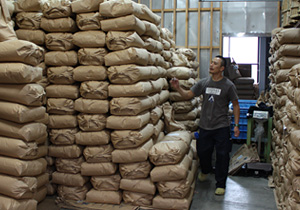 Most is “Yamada Nishiki”, a rice variety well suited for sake brewing. Yamada Nishiki was born in Hyogo Prefecture. Currently, it is widely grown, from Kyushu in the South to Southern Tohoku in the North.
Most is “Yamada Nishiki”, a rice variety well suited for sake brewing. Yamada Nishiki was born in Hyogo Prefecture. Currently, it is widely grown, from Kyushu in the South to Southern Tohoku in the North.
Yamada Nishiki is a sake rice variety well suited for sake brewing, and indispensable for brewing high-grade sake. We have contracts with farmers in Special Area A in Hyogo Prefecture for “Tojo Yamada Nishiki (registered trademark)” rice, which comprises about 65% of the total amount of rice used at our brewery. This area produces and harvests the finest Yamada Nishiki rice. The shape of the land in former Tojo Town is good.
The brewery owners of ten companies from around the nation gathered to establish the “Frontier Tojo 21″, with the aim of self-reliance and coexistence with “Tojo Yamada Nishiki”. In this way, we humbiy walk alongside local farmers.
Rice Washing
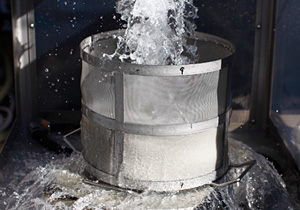 Washing the sake rice is the first step in brewing good quality sake. with a stopwatch in hand, limited water absorption rice washing is carried out by the seconds, using 500L or more of water for 10kg of sake rice, completely washing away any slime on the surface of the sake rice. At the same time, the sake rice is allowed to absorb a limited amount of water.
Washing the sake rice is the first step in brewing good quality sake. with a stopwatch in hand, limited water absorption rice washing is carried out by the seconds, using 500L or more of water for 10kg of sake rice, completely washing away any slime on the surface of the sake rice. At the same time, the sake rice is allowed to absorb a limited amount of water.
Rice washing is also called second rice polishing. We give rice washing our full attention.
Steamed Rice
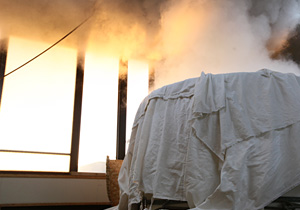 The washed sake rice is then steamed under the best condition.
The washed sake rice is then steamed under the best condition.
Steamed sake rice is light and fluffy, and has a good quality, sweet perfume scent.
“Yamada Nishiki” (a brand of sake rice) smells like fresh hay when cooled. Such superb steamed rice is possible with cleanly washed sake rice. We use a steamer made from sawara cypress (“koshiki”), which gently cradles the rice. We are very careful during rice steaming. To say that rice steaming is the most important process in sake brewing is not an exaggeration.
The Making of “Koji” (koji spores grow on the surface of steamed rice)
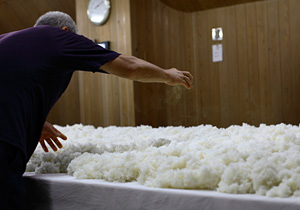 “Koji”, for use in “shubo (moto)” (yeast starter), and “moromi” (fermenting sake mash) during “honjikomi” (the main fermenting process), is completely made by hand according to our original method in the cedar “koji” room, requiring many hours. Koji is grown by traditional techniques, and is showy in appearance (fungus body and hypha are shallowly planted into steamed rice), with its spores exposed and smells like mushrooms. Koji cannot be made in a day.
“Koji”, for use in “shubo (moto)” (yeast starter), and “moromi” (fermenting sake mash) during “honjikomi” (the main fermenting process), is completely made by hand according to our original method in the cedar “koji” room, requiring many hours. Koji is grown by traditional techniques, and is showy in appearance (fungus body and hypha are shallowly planted into steamed rice), with its spores exposed and smells like mushrooms. Koji cannot be made in a day.
To match the excellent kobo (yeast) maintained at our company, we spend 70 hours without sleeping to make “koji” for “Daiginjo” grade. This is the source of the distinctive taste of Isojiman.
“Shubo” (yeast starter)
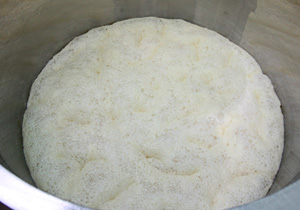 We use only fast fermenting “shubo” which requires a half month for fermentation.
We use only fast fermenting “shubo” which requires a half month for fermentation.
We put our heart into the making of “Koji”, cooling the steamed rice to the right temperature, and adding into brewing water the excellent yeast maintained at our company. Then the pure yeast culture is cultivated in the refrigerated “shubo” room finished with coated aluminum. For the first 3-5 days, “shubo” is teased by the initial temperature adjustment. “Shubo” feels stress, and releases a sulfuric smell (like a natural hot spring). This sulfuric smell will change into a wonderful natural, fruity scent such as muskmelon, LaFrance pear, Fuji apple, ripe bananas, or passion fruit.
There are more than 150 million yeasts in 1ml of finished yeast.
You may be amazed by the world of biotechnology, and at the same time, wonder why such a fruity scent can come from sake.
We do not use yeasts from the caproic acid group at all.
“Moromi”
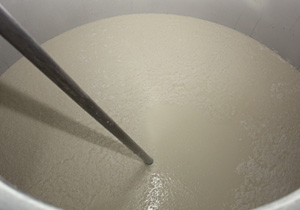 All the fermentation and storage tanks are placed in refrigerated brewing room finished with stainless steel.
All the fermentation and storage tanks are placed in refrigerated brewing room finished with stainless steel.
Since 1985, we were the first in the nation to carry out sake brewing in a “large refrigerator room” with tank storage. This was the turning point in quality enhancement of our low temperature fermentation, namely, “ginjo-zukuri” (ginjo means “special brew sake”, and zukuri means making or brewing).
The refrigerated room is finished with stainless steel for sanitation reasons. Glass lined fermentation tanks also provide very good conditions for sake.
“Joso” (press separation of sake) and”Shibori” (pressing)
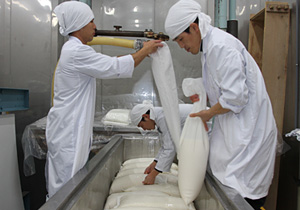 We use an old-style press “so” and two automatic presses in a “refrigerator” finished with stainless steel. The brewing room is similarly finished with stainless steel. This is the result of our desire to provide the best “ginjo-zukuri”.
We use an old-style press “so” and two automatic presses in a “refrigerator” finished with stainless steel. The brewing room is similarly finished with stainless steel. This is the result of our desire to provide the best “ginjo-zukuri”.
We came across this idea from freezing technology (-85°C) of Yaizu, a fishing town in temperate Shizuoka Prefecture.
We chose to brew sake in refrigerated pressing room because, first, the temperature of “moromi” before pressing is about 5°C low.
Moreover, it is a clean environment.
Storage
All of our sake is preserved in bottles and tanks in a low temperature refrigerator.
Since the early Showa period, bottle storage for sake treated by a lengthy “bin-hiire” method (bottle of sake are treated with low heat) and then the bottle are laid on their side in a low temperature refrigerator.
Low temperature bottle storage has been carried out since 1983.

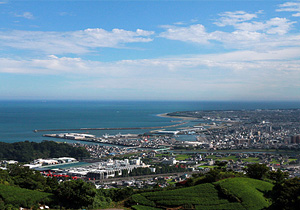
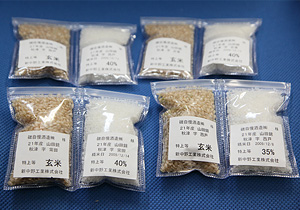
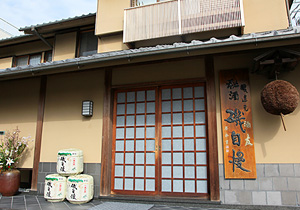
 At the end of October, a cool wind begins to blow in the morning and evening. And Isojiman”s sake brewing begins with a religious service honoring the God of sake brewing.
At the end of October, a cool wind begins to blow in the morning and evening. And Isojiman”s sake brewing begins with a religious service honoring the God of sake brewing. Most is “Yamada Nishiki”, a rice variety well suited for sake brewing. Yamada Nishiki was born in Hyogo Prefecture. Currently, it is widely grown, from Kyushu in the South to Southern Tohoku in the North.
Most is “Yamada Nishiki”, a rice variety well suited for sake brewing. Yamada Nishiki was born in Hyogo Prefecture. Currently, it is widely grown, from Kyushu in the South to Southern Tohoku in the North. Washing the sake rice is the first step in brewing good quality sake. with a stopwatch in hand, limited water absorption rice washing is carried out by the seconds, using 500L or more of water for 10kg of sake rice, completely washing away any slime on the surface of the sake rice. At the same time, the sake rice is allowed to absorb a limited amount of water.
Washing the sake rice is the first step in brewing good quality sake. with a stopwatch in hand, limited water absorption rice washing is carried out by the seconds, using 500L or more of water for 10kg of sake rice, completely washing away any slime on the surface of the sake rice. At the same time, the sake rice is allowed to absorb a limited amount of water. The washed sake rice is then steamed under the best condition.
The washed sake rice is then steamed under the best condition. “Koji”, for use in “shubo (moto)” (yeast starter), and “moromi” (fermenting sake mash) during “honjikomi” (the main fermenting process), is completely made by hand according to our original method in the cedar “koji” room, requiring many hours. Koji is grown by traditional techniques, and is showy in appearance (fungus body and hypha are shallowly planted into steamed rice), with its spores exposed and smells like mushrooms. Koji cannot be made in a day.
“Koji”, for use in “shubo (moto)” (yeast starter), and “moromi” (fermenting sake mash) during “honjikomi” (the main fermenting process), is completely made by hand according to our original method in the cedar “koji” room, requiring many hours. Koji is grown by traditional techniques, and is showy in appearance (fungus body and hypha are shallowly planted into steamed rice), with its spores exposed and smells like mushrooms. Koji cannot be made in a day. We use only fast fermenting “shubo” which requires a half month for fermentation.
We use only fast fermenting “shubo” which requires a half month for fermentation. All the fermentation and storage tanks are placed in refrigerated brewing room finished with stainless steel.
All the fermentation and storage tanks are placed in refrigerated brewing room finished with stainless steel. We use an old-style press “so” and two automatic presses in a “refrigerator” finished with stainless steel. The brewing room is similarly finished with stainless steel. This is the result of our desire to provide the best “ginjo-zukuri”.
We use an old-style press “so” and two automatic presses in a “refrigerator” finished with stainless steel. The brewing room is similarly finished with stainless steel. This is the result of our desire to provide the best “ginjo-zukuri”.